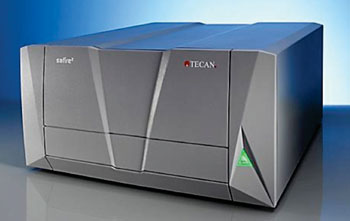Novel Technology Diagnoses Stroke Quickly
By LabMedica International staff writers
Posted on 08 Dec 2015
A new approach to identifying biomarkers in blood has proven successful in helping diagnose stroke, and the technology could be expanded to diagnose such conditions as concussion, some forms of dementia, and some types of cancer and heart disease.Posted on 08 Dec 2015
There is pressing need for quick and objective diagnostic technologies for both time sensitive and difficult to diagnose pathologies. Much attention has therefore focused on the identification of disease-specific peripheral biomarkers, and use of new technologies to improve antibody-based detection capabilities.

Image: The TECAN Safire UV-VIS-IR and fluorescence microplate reader (Photo courtesy of California Institute of Technology).
Scientists at Cornell University (Ithaca, NY, USA) and their colleagues used a biomimicry-based approach to demonstrate a new diagnostic platform, based on enzymes tethered to nanoparticles (NPs). As proof of principle, they used oriented immobilization of pyruvate kinase (PK) and luciferase (Luc) on silica NPs to achieve rapid and sensitive detection of neuron-specific enolase (NSE), a clinically relevant biomarker for multiple diseases ranging from acute brain injuries to lung cancer.
They performed in vitro, animal model, and human subject studies. They used tethered enzyme assay for detection of NSE in samples from 20 geriatric human patients. Freshly collected plasma was diluted with water and added to individual wells of a 96-well plate preloaded with lyophilized Tethered Enzyme Technology (TET) reagent mixtures for negative, test and positive control wells in triplicates. The readout luminescence signal was integrated for 0.4 seconds, and read continuously for 25 minutes using a Safire plate reader (TECAN; Männedorf, Switzerland). For calculation of NSE levels, the linear regression slope for the initial activity was calculated per each well.
The scientists found that their data correlated very well with the current gold standard for biomarker detection, enzyme-linked immunosorbent assay (ELISA) with a major difference being that they achieved detection in 10 minutes as opposed to the several hours required for traditional ELISA. Alexander J. Travis, VMD, PhD an Associate Professor of Reproductive Biology, and lead author of the study said, “This system could be tailored to detect multiple biomarkers. That's the strength of the technique. You could assemble a microfluidic card based on this technology that could detect ten biomarkers in different wells, and the readout would be the same for each one: light. Using the same detection system for multiple different biomarkers would make for a simple system in a relatively small package.” The study was published on November 25, 2015, in the journal Public Library of Science ONE.
Cornell University
TECAN
Related Links:














